Rejoice, fans of tiny tabletop warriors. Warhammer Age of Sigmar: Storm Ground is one of the first full-fat Age of Sigmar video games adaptations and… it’s pretty good?
Ok, it isn’t without its rough edges, but as a fan of Age of Sigmar, I am glad that Games Workshop’s prog-metal-album-cover fantasy game finally gets an outing on consoles and PC.
Warhammer Age of Sigmar: Storm Ground Review — A Challenging Romp through the Mortal Realms
Storm Ground is a turn-based strategy game that plays out on a series of hex-grid arenas in the Mortal Realms, Age of Sigmar‘s planes of magic style setting. Each campaign involves you taking control of one of three factions on offer, and tackling a series of increasingly difficult challenges.
The three forces are Sigmar’s resplendent Stormcast Eternals, lightning forged warriors from the realm of Azyr; the cruel, spectral Nighthaunt from the realm of Shyish; and the corpulent, corrupted Maggotkin, worshipers of the plague god Nurgle.
Each of these factions is led by a unique hero, and has three campaigns set across the realms. The actual structure of the game is fairly interesting, so let’s break it down.
The first campaign, and the most straightforward, and your first few missions are tutorials. This introduces the game’s hex-based combat and the two basic units of the Stormcast Eternals: stalwart tank units called Retributors and ranged artillery units called Castigators.
Combat is high-risk, high-reward. Most units have a basic attack and an ability or two (with heroes often having two or three), as well as passive abilities that proc in certain circumstances. As an example, Retributors will buff the defense of adjacent units. Every unit also has the expected attack, health, defense, and move characteristics.
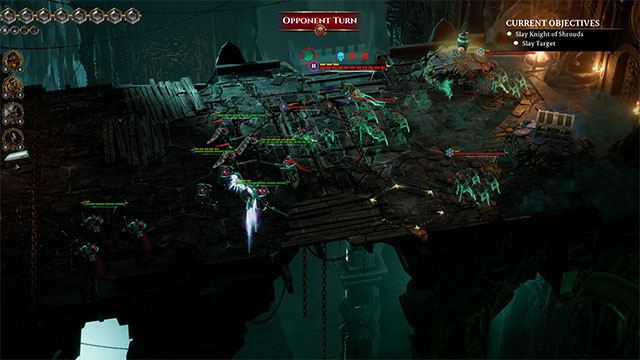
Storm Ground does a mostly good job of conveying information before you commit to an action: move into range, and the UI will show you that enemies can target you. Hover over an enemy to attack them, and it will show you how much damage they will take — and how much you’ll take in return.
It’s helpful because combat is particularly lethal. Armor will mitigate some damage, with a percentage chance to entirely deflect damage, and it’s sorely needed. Attacks can easily melt your units, and you’re frequently outnumbered and outgunned. If one of your units dies in combat, they are dead for good. Lose your hero, and the campaign is over.
Except, of course, this is a rogue-like of sorts. Every time you die, you get back up and try again.
You’re able to keep three of your units (represented as cards through the in-between mission loadout screens) and any wargear equipped to them. It’s an interesting wrinkle and reflects both the lore of Age of Sigmar and the way you’ll take your favorite units off the table in one game and put them back on for another round.
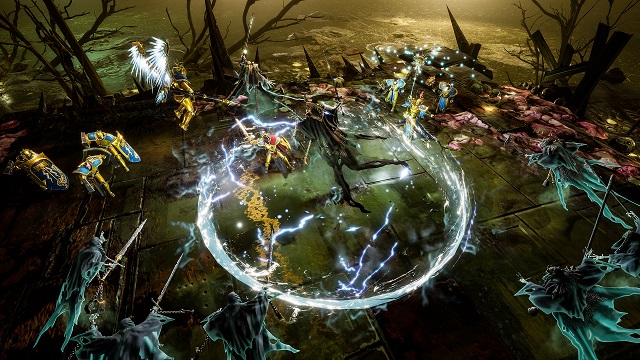
Once you’ve completed the initial mission, you are free to pick between two missions, each with different rewards, such as new unit cards or wargear and equippable skills. Chests hiding in out-of-the-way places in each mission can be picked up for extra awards, and equipping skills that synergize with your heroes and units, such as extra damage when a unit kills another unit, let you diversify your Warband.
These upgrades come with a price, though, and as you stack equipment on units, their summoning cost increases, another wrinkle in Storm Ground‘s design. While your opponents will appear in waves, you will only start with your hero, limited to spawning on set hexes.
You start with three aether, your summoning currency, and each turn you get one more, allowing you to summon units. Stormcast summon adjacent to their hero, making strong defensive castles, while Nighthaunt and Maggotkin must generate spirit wisps and corruption hexes to summon from, allowing for tactical play.
Adding perhaps one layer too many to the game, abilities cost energy and have a cooldown. Energy is generated from your third or fourth turn, again increasing per turn, but this structure locks powerful abilities behind them.
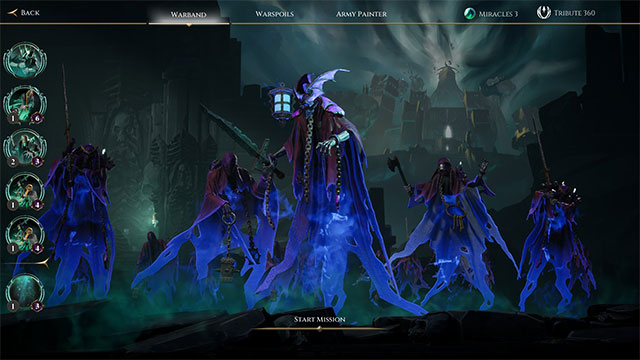
It goes without saying that combat in Storm Ground requires careful planning. Lining up swift killing blows, trading units only when you absolutely have to, and using area of effect attacks alongside abilities to manipulate movement, gain high ground, and block terrain to funnel enemies into chokepoints is all part of every fight.
Nighthaunt and Maggotkin have it tougher than the heroic Stormcast, too, as they rely on debuffs and map control to gain an advantage over their foes.
It can be pretty overwhelming at times, and there are a handful of missions — especially the final mission in each campaign — that can feel insurmountable until you’ve worked out a playstyle and strategy. I was hammering my head against the end of the Nighthaunt campaign for a while, as some high-level enemies are incredibly tanky and hit hard, but the game gave me a few solutions to work with.
Ultimately, I ended up having a particular combo that made one unit of ranged Chainghasts grow exponentially stronger each time it killed an enemy, and I spent the battle chipping away at small units until they could take huge chunks off of the boss. It was satisfying to put in practice, but having to start from scratch over and over was often demoralizing.
On the opposite end, early battles can be quite basic. Having to wait on placing units and putting your strategies into play as you pick missions and hope you get the right unit as a reward can be a bit fatiguing.
It’s also worth noting that the UI itself can also be a bit cluttered, with basic icons and information hidden away in unit descriptions. This wouldn’t be a huge issue, but actually getting around the UI is sluggish and frustrating. It’s the biggest negative for the game, with no quality of life options for speeding up moves. Animations are canned and often awkward, but the inability to skip them, especially on reruns of early missions can be frustrating.
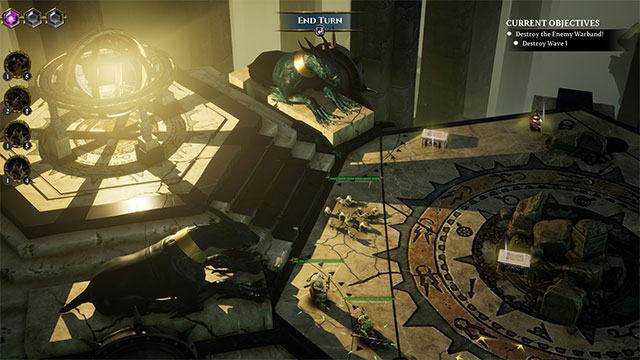
Visually the game is every inch an Age of Sigmar game, with each arena a little microcosm of Warhammer excess, nestling in greater dioramas that really get across how grand and bizarre the realms are. Though the mechanics here are the meat of the offering, the set dressing is certainly great.
Storm Ground isn’t the most visually well-polished you’ll play, but skulking around the branches of a colossal tree in Ghyran or reclaiming a Nurgle in Chamon, the realm of metal, really reinforce that wild fantasy vibe that Age of Sigmar has.
The voice acting also matches the setting. The phlegm-filled utterances of the Maggotkin as they denounce the “golden fools” of the Stormcast, who bellow back in zealous proclamations of faith, aren’t high theatre, but they’re 100% scenery-chewing Age of Sigmar. They had me chuckling along.
In short, it’s a world of immortal heroes and villains, so it’s fitting that it plays out with that very particular sense of Warhammer humor and pathos.
Warhammer Age of Sigmar: Storm Ground — The Bottom Line
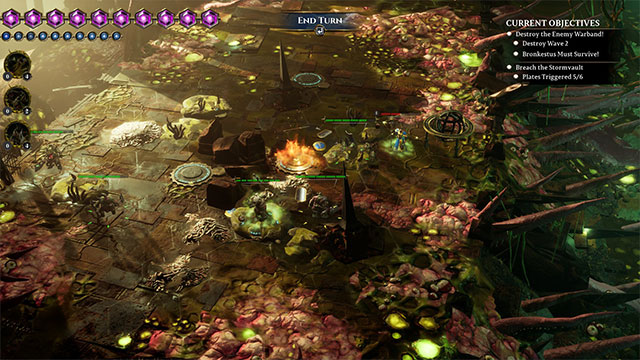
Pros
- Bold visuals
- Over the top dialogue
- Punishing but satisfying turn-based combat
- A wide range of units, equipment, and skills make for diverse strategies
- A lot of content on offer, with nine campaigns at launch
Cons
- Lacking some visual polish
- Very clunky UI
- Difficulty can often feel stacked against you
- Roguelike nature can make progression a slog
- A number of crashes and technical issues with the UI, as well as units and AI bugging out
After clearing each of the three basic campaigns, there is the option to explore longer, more varied campaigns that require you to conquer two realms, offering you a chance to play with new heroes. There’s a lot on offer here, but I’ll admit its roguelike structure feels daunting and even outright tiring given how brutal and punitive the game can be at times.
Storm Ground has some rough edges: janky animations, a handful of crashes, and a brutal difficulty curve. There are some quality of life issues as well. Hunting out powerful units, wargear, and skill combinations is compelling, but it is unfortunately too random because of the loot card nature of rewards. And the way you need to discard all but two of your favorite units when you fail a campaign can sting.
But I keep coming back to a simple fact: it’s an Age of Sigmar game. It’s not perfect, but it conveys the attitude and atmosphere of the setting. The factions convey their unique mechanics well, and that’s a big plus in a Warhammer game. It’s a promising first step into the Mortal Realms, but not one I’d recommend to anyone but the most diehard fans of Age of Sigmar without a wealth of caveats.
[Note: Games Workshop provided the copy of Warhammer Age of Sigmar: Storm Ground used for this review.]







Published: May 26, 2021 8:31 PM UTC